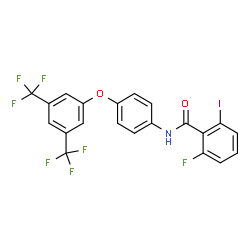| Cas No.: | 2471982-20-2 |
| Synonyms: | CU-115 |
| SMILES: | O=C(NC1=CC=C(OC2=CC(C(F)(F)F)=CC(C(F)(F)F)=C2)C=C1)C3=C(I)C=CC=C3F |
| Formula: | C21H11F7InO2 |
| M.Wt: | 569.21 |
| Purity: | >98% |
| Sotrage: | Please store the product under the recommended conditions in the Certificate of Analysis. |
| Publication: | [1]. Rosaura Padilla-Salinas, et al. Discovery of Novel Small Molecule Dual Inhibitors Targeting Toll-Like Receptors 7 and 8. J Med Chem. 2019 Nov 27;62(22):10221-10244. |
| Target: | TLR8:1.04 μM (IC50) TLR7:50 μM (IC50) |
| In Vitro: | In endosomal and non-endosomal TLR specificity studies, Human embryonic kidney (HEK) 293 cells expressing human tolllike receptor (hTLR) gene and an inducible secreted embryonic alkaline phosphatase (SEAP) reporter gene were incubated with CU-115 for 16 hours. As a result, CU-115 displays activity for TLR7 and TLR8 at low concentrations (0.5 μM). CU-115 does not modulate the NF-kB inhibition induced by Pam2CSK4, Pam3CSK4, Poly(I:C), LPS, R848, and Flic in HEK-293 TLR1/2, TLR2/6, TLR3, and TLR4 cells. And CU-115 inhibits TLR9 signaling at 1, 5, and 20 µM and ~10-25% inhibition. CU-115 (5-20 µM) inhibits increases in type I IFN transcriptional activity induced by the ssRNA nucleic acid ligands 3p-hpRNA or G3-YSD in a luciferase reporter assay. CU-115 (0.5, 1.0, 5, and 20 µM; 16 hours) is nontoxic at low concentrations (0.5 and 20 μM) and toxic at 100 μM in Hek293 TLR7 and TLR8 cells. CU-115 also is nontoxic at low concentrations (0.5 and 20 μM) and displays partial toxicity at 100 μM in THP Dual cells. The enzyme-linked immunosorbent assay (ELISA) is performed to measure upregulation/inhibition of TNF-α in human THP-1 cells (hTHP-1). CU-115 (5-20 µM) abolishes the TNF-α production activated by R848 (1 µg/ml) in hTHP1. It also represses the expression of IL-1β in hTHP-1 cells. These results suggest that CU-115 suppresses TLR8 and TLR7 signaling pathways. |
| References: | [1]. Rosaura Padilla-Salinas, et al. Discovery of Novel Small Molecule Dual Inhibitors Targeting Toll-Like Receptors 7 and 8. J Med Chem. 2019 Nov 27;62(22):10221-10244. |

 DC Chemicals' products qualify for U.S. tariff exemptions. We guarantee no price increases due to customs duties and maintain stable supply, continuing to deliver reliable research solutions to our American clients.
DC Chemicals' products qualify for U.S. tariff exemptions. We guarantee no price increases due to customs duties and maintain stable supply, continuing to deliver reliable research solutions to our American clients.





















